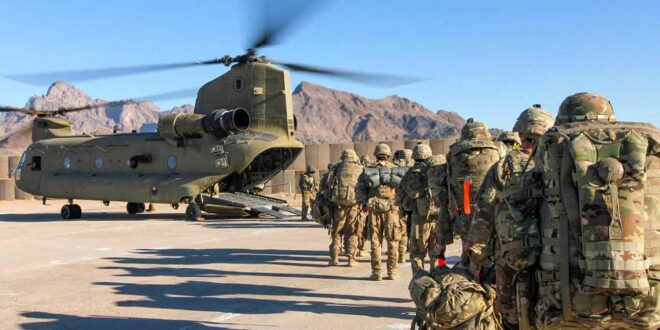Articles: The retelling of the Greatest Military Escape – The escape of American soldiers from Afghanistan drew the horizon of their desertion from Iraq to the Persian Gulf and peninsula countries and West Asia in general.
Saadullah Zarei wrote in a note in Kayhan newspaper: August 24th was the anniversary of the disgraceful escape of the American invading army from Afghanistan. To pretend that it has maintained its operational power in Afghanistan and that its goal was to confront the borderless militant groups, near the first anniversary of his escape, with the help of Pakistan’s intelligence service, it carried out a drone operation against Ayman al-Zawahiri, the Egyptian leader of al-Qaeda, on the home of Jalaluddin Haqqani, one of the Taliban leaders in Kabul.
In the meantime, the Taliban, who denied the presence of Al-Qaeda leaders in Afghanistan, could not react sharply against the joint action of the United States and Pakistan against their special guest. There are some tips about this topic:
1. The military occupation of Afghanistan in 2001 began under the pretext of attacking the twin towers of Manhattan, but its goal was to establish a long-term military domination in Afghanistan – which Kissinger talked about for 100 years – to control Iran, Russia, China, and India.
For this purpose, America created the ISAF military alliance and asked the western countries to participate in this alliance, even if only symbolically sending a small unit. The total number of these forces mentioned is between 36 and 50 thousand, which reaches about 130 thousand people, including the American military forces.
These forces decreased over time and, almost five years after the occupation of this country and the emergence of differences between the American military forces and the others, especially the differences between the United Kingdom and the United States, the number of Western military forces in Afghanistan reached about 70 thousand people in the following years. Finally, the Western governments’ military forces returned to their countries, and the American troops reached a figure of less than 50,000.
With the deadlock of the long-term and active military occupation method, the US considered an affiliated Afghan government. As a result of the election, “Hamid Karzai” became the president. At first, Karzai considered the presence of American troops in his country as an antidote to the Taliban’s attack on the central government and supported it. Soon, he realized that the US did not have any interest in the existence of a powerful government in Kabul. For this reason, a rift between the Karzai government and the US-led ISAF emerged.
After that, the government existed in a weak form in Kabul, but in practice, the Americans were in charge of many security and political affairs in Afghanistan. This issue constantly increased the scope of the dispute between Kabul and America. Simultaneously with the differences between America and the weak government that came to work in Kabul, the Taliban was advancing in different parts of Afghanistan and taking over the security control of many provinces. This movement intensified after the end of Karzai’s presidency and the beginning of Ashraf Ghani’s work.
Unlike Karzai, Ghani became president by cheating against Dr. Abdullah Abdullah. Thus the differences within the Afghan government intensified during Ghani’s term, and the Taliban took advantage of these differences and increased their circle of control in Afghanistan.
2. Between 2006 and 2021, with the Taliban gaining power, the authority of the occupying forces and the government, which had come to work in a weak democracy, was gradually reduced. Finally, the government of Kabul reached the point of dissolution.
On the other hand, the policy of the Islamic Republic of Iran, based on the expulsion of America from Afghanistan and designed and implemented measures under it, narrowed the field for the Americans and made the horizon of long-term American domination hopeless for Washington.
The Americans were in a situation where they had to negotiate with the powerful Afghan opposition group, the Taliban, and find a way to solve the problem. Therefore, negotiations between the United States and the Taliban began in Doha.
The Doha negotiations started with two intentions. The work included two different agendas. The Americans negotiated with the motivation to reach an agreement with the Taliban on the survival of their military forces in this country, and the Afghans started the negotiations to force America to accept their government.
In the first talks, Zalmay Khalilzad and Mollabrader agreed that the relationship between the US and the Taliban is not hostile under any condition. In the later steps, the Americans reached an agreement with the Taliban for one year and based on that, they decided that during this one year, the Taliban would not have anything to do with the American military forces and prevent attacks on the American troops in the areas under their control. The government and the Taliban remain neutral!
The negotiations, which lasted almost two years, finally led to the acceptance of the withdrawal from Afghanistan by the United States. In return, the Taliban agreed to guarantee the safe quit of the Americans from Afghanistan.
The Islamic Republic monitored the Doha negotiations between the Taliban and the United States carefully. The Islamic Republic desired that the United States leave the territory of Afghanistan without taking concessions.
Based on this, she would remind Afghan friends of some points when necessary. The Islamic Republic of Iran had the experience of expelling American soldiers from Iraq. In this country, Iran adopted a policy that resulted in the American forces being in a tight spot and accepting the withdrawal from this country. In this process, Iran persuaded the Iraqi friends to emphasize the complete withdrawal, not a reduction of the presence. At the same time, it followed the pressure on the American forces in the Iraqi social structure. This formula was effective for Afghanistan as well. For this reason, the Doha negotiations continued and, under the guidance of Iran, resembled the Baker-Hamilton negotiations in Iraq.
3. A few years after the military presence, America had reached a situation where its three presidents – Obama, Trump, and Biden – could not defend the reason and process for America’s presence in Afghanistan. Therefore, the necessity of leaving Afghanistan and protesting the staggering expenses in this country had become the priority of the statements of the American political and military officials.
Interestingly, the Commander-in-Chief of the United States cannot defend his country’s military policy.
The fact was that Afghanistan had turned into a cemetery on one side and a prison on the other side for American forces. This issue was more related to the anti-western spirit of the Afghan people than to the Taliban and its power.
One of the American soldiers, who has been in Afghanistan for many years as an intelligence officer, published a book on the eve of America’s expulsion from Afghanistan, in which he wrote, “We failed from the suburbs of Afghanistan; Although the villagers received our food aid due to struggling with poverty, they did not have a good view of us at all.
Those who helped us during the day (we paid them regularly) acted against us at night and in favor of the Afghan Mujahideen. From their point of view, we were ultimately considered aggressive infidels, and the Afghan mujahids were considered liberation mujahids. We had no chance in Afghanistan and could not stay in this country in any way.
What this intelligence officer described in his detailed book shows well the social reason for America’s failure, but America’s expulsion from Afghanistan had three aspects; A strategic and strategic side which was the Islamic Republic of Iran, a military side which was the Taliban and a social side which was the masses of the Mujahid people of Afghanistan.
America has run away from Afghanistan for more than a year, and the image and result of this fight have shown its failure and weakness. The escape of American soldiers from Afghanistan drew the horizon of their quit from Iraq to the Persian Gulf and peninsula countries and West Asia in general.
 Mouood Mouood English Edition
Mouood Mouood English Edition




